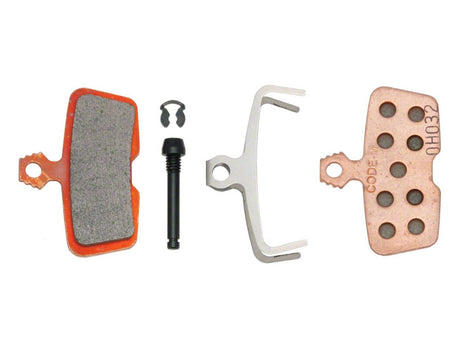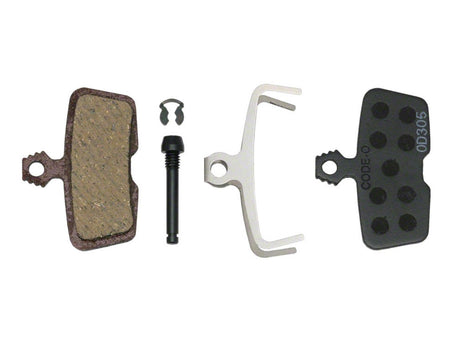Intro
If you like going fast, then you also have to like slowing down, and brake pads are your best friend for that.
These little guys get pushed by your brake caliper pistons and squeeze together on your brake rotor, causing your tire to dig into the dirt and slow you down. If you’re looking for more braking performance out of your current set up, or if it’s time to replace worn out brake pads, then you want to make sure you’re putting in the perfect brake pad for your riding style and the conditions you ride in. You need to know the differences between different types of brake pads and which situations each of them excels in, so let’s break it down.
No matter how powerful your brakes are, at the end of the day, it’s your brake pads squeezing that rotor that actually do all of the braking. That’s why it’s the first place to start when you’re looking for better performance out of your fancy brakes. There are a few different flavors of brake pads, and each of them has their pros and cons.
The biggest difference between types of brake pads is the braking compound on the pads!
The two most common options are organic (aka resin) and metallic (aka sintered). They all look pretty similar to the naked eye, and you have to dive into their composition to understand what really sets them apart from each other.
Materials and How The Pads Are Made
Organic pads are made of tiny little fibers and other organic materials like rubber and graphite that are bonded together with resin. That’s why people call them resin pads!
Metallic pads are made of a mixture of metallic compounds like copper, nickel, and iron which are bonded together through sintering. Sintering is turning a liquid compound into a hard solid compound through high amounts of pressure and heat, which is how metallic pads have gotten their nickname of sintered pads.
Semi-metallic pads are a combination of the organic and metallic pad material bonded together with resin to try and combine both of their best qualities into one super pad! Each brand of semi metallic pad is a bit different from each other because they have different ratios of organic fibers and metallic bits, so they all feel a bit different on trail.
Ceramic pads are a more niche form of mountain bike brake pad and are made of a really similar material to ceramic pots, but quite a bit more dense and durable. They’ve also got super fine copper fibers embedded in them to help increase friction and heat dissipation.
Because of the difference in how these pads are made and what’s actually inside of them, they perform super differently out on the trail! Let’s check out what you can expect from each of these pads.
On Trail Feel and Differences
Organic
Out on the trail, organic pads have a smooth feel at the lever with minimal vibration and feedback coming back to your hands, and they’re also one of the quietest compounds.
Because they’re made of a bit softer material than other compounds, they’ll take the shortest time to bed in but that also means they won’t last as long as other options. Like you can probably imagine, because it’s made of a softer material, it’s just going to wear out a bit quicker than a harder metallic pad, and that’s especially true in wet conditions. During those wet winter months, with all that water and grit finding its way onto your rotor and pads, you’ll go through those organic pads quicker than a block of parmesan at an Olive Garden.
The organic compounds have the lowest maximum operating temperatures of any compound, so they’ll start glazing before any other types of pads. Once a pad has gone over that max temp, all the fibers and organic bits in there get melted together and won’t offer the same performance ever again.
Most bikes come spec'd with organic pads so if you’re not sure which pads you’re rocking right now, chances are they’re organic!
Metallic
Metallic pads are made of a hard metal composition, and have very different properties to organic pads.
That more resilient compound will last longer and they offer lots of power in all conditions. Metallic pads have a very strong bite when you pull the levers, giving all of their power right when you grab the lever. One of their strongest points is their wet weather performance. Even on the muddiest days they’ll still grab with the same power as if they were dry, and that’s why these are a super popular option during the rainy season when we can expect a bit of rain on pretty much every ride.
Their metallic construction will transfer more heat to the calipers and in turn, the fluid. But the pads themselves are very resistant to heat, and this will keep them from glazing for a bit longer on those big descents. These are the loudest brake pads which doesn’t bother everyone, but if you’re especially sensitive to how loud your bike is, this could be something to consider. Also, with that added friction, they’ll wear down your rotors a bit quicker than organic pads.
Semi-Metallic
Semi Metallic pads are another common option, and are a bit of middle ground between organic and metallic pads.
By combining the material used for both of those pad types, they’re supposed to be the super pad that offers the best of both worlds. These are made in the same way as organic pads, being bonded together with resin rather than being sintered like metallic pads. Because of their resin construction, these are also more prone to glazing than a metallic pad, and can be thought of as a more powerful organic pad.
Something to be aware of is that each company’s version of a semi metallic pad is different because they all use different ratios of metallic and organic compounds, so each one will give different performance out on the trail. That being said, they aim to provide better performance in the wet than organic pads, less noise and rotor wear than metallic pads, and better heat resistance than organics. But they don’t have quite the power or wear life as metallic pads.
Ceramic
Ceramic pads are another option when it comes to brake pads, but they haven’t gotten quite the recognition of organic or metallic pads.
Ceramic compounds are super popular in motorcycles and cars, but really haven’t made the transition over to mountain bikes until recently. They’re constructed in a similar way to resin pads in that the ingredients are bonded together with an adhesive compound. Ceramic pads can last even longer than metallic pads, and have a similar amount of power, but don’t have that same initial bite. They’ll come on a bit more smoothly and can give you more modulation if you feel like your brakes are a bit too touchy. They’ve also got some of the smoothest feeling at the lever, and are super quiet just like resin pads.
Ceramic pads are highly resistant to heat, so if you’re having trouble with your brakes fading, these could absolutely be worth trying out.
Which One Is Best For You?
If you’re a casual rider who isn’t trying to brake late for corners or rip the longest descents around, then organic pads are a great option! You can enjoy their quiet performance and low impact on your brake rotors, and sometimes they’re a bit cheaper than other options.
If you’re a fan of how those organic pads feel, but you’re just looking to bump up the power a little bit, or if you find yourself on the occasional rainy ride, then those semi-metallic pads are going to be perfect. Since they’ve got some metal sprinkled in there with the rest of the organic material, they are going to give you a bit more friction against that rotor and perform better in both wet and dry conditions. But because they’re both constructed the same way with the resin holding it all together, they’re both more prone to glazing.
So, if you’re pulling over to let your brakes cool down halfway down your trail, or if you find yourself getting caught in the rain more than you’d like, then you may want to step up to either the ceramic or full metallic options. Both of these compounds perform great in both wet and dry conditions but they feel pretty different to each other.
The metallic pads have the most bite of any option, and if that’s what you’re looking for, then look no further. These have been the gold standard for brake pads for years, but ceramic brakes have been getting a bit more popular recently and are trying to shake things up.
The ceramics offer more modulation because they don’t come on quite as strong as the metallics, but they still have lots of power if you really get on the brake levers. The ceramic pads also have a completely different feel at the lever that’s just a bit smoother than the metallic pads and almost feels like there’s less friction getting transmitted back to you. Combined with how quiet they are, these are like the Bentley of brake pads while the metallics are like a Ferrari. The Bentley still has that V10 under the hood but it's also got the heated seats and a great sound system. While the Ferrari sacrifices those creature comforts and goes all out on that screaming V12.
Summary
So what do you think is right for you? Do you want to hear the roar of the Ferrarri V12 with those metallic brakes, or maybe the super comfortable Bentley that can still get up and go is more your speed. Or do you want to go to the grocery store and pick up the kids from soccer practice in your Prius with those organic pads?
Personally, I’ll run metallic pads year round because of how long they last and their resistance to glazing. We’ve got some fairly steep trails here where you’re hard on the brakes the whole way down so I really appreciate their resistance to glazing and super consistent performance all year round.
Just a quick note, before you install your new brake pads, if you’ve used these rotors before, go ahead and give them a thorough clean up. That includes sanding off the residual brake pad material and giving it a rub down with some isopropyl alcohol to make sure it’s a perfect surface to bed your brake pads into. Even if you’re replacing your brake pads with the same model, you still want to start a fresh rotor surface for the fresh pads.














